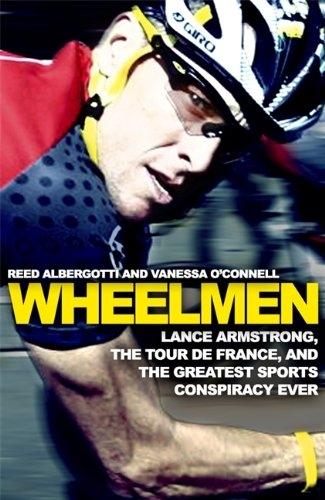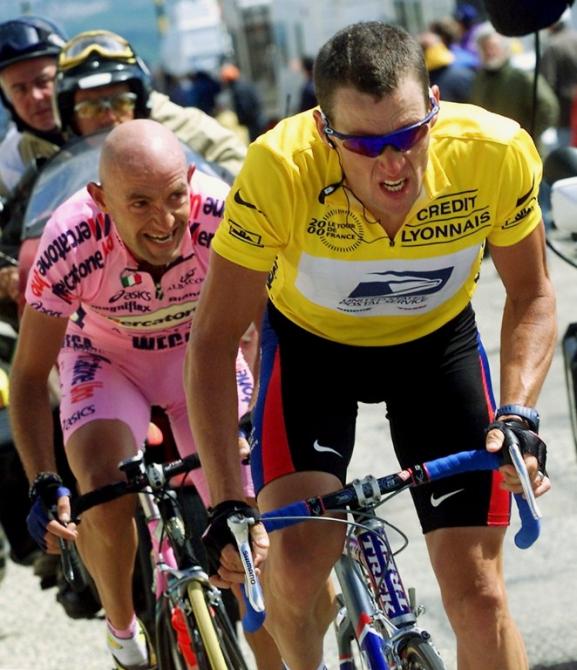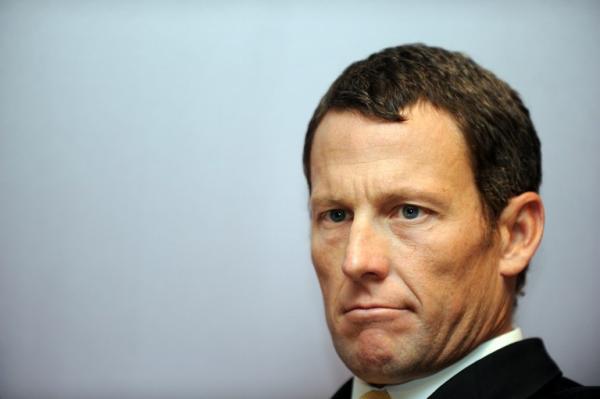Wheelmen book excerpt: What to do about Lance Armstrong
Chapter 13 details Floyd Landis' predicament



Several books have already been written about Lance Armstrong, but the latest –"Wheelmen" by Reed Albergotti and Vanessa O’Connell, reveals new details of the Texan’s secret past and eventual downfall thanks to a detailed interview with Floyd Landis and numerous other people who were close to him.
The book uncovers the early years of Armstrong’s career and his Lothario life style, gives details of his spat with Greg Lemond, his use of performance enhancing drugs, the culture of cheating and is ability to bully anyone who dared go against him.
Cyclingnews has obtained an excerpt from Wheelmen which will be published in two parts. This first part tells the story of Floyd Landis’ decision to confess to doping and how Armstrong and those who supported the Texan tried to stop him. It reveals the secret influence Armstrong held over Landis and how he and others used it.
The second part will be published on Monday.
Wheelmen can be purchased in bookshops and online by multiple retailers, including Amazon.
Chapter 13: Betrayal
At the start of 2007, six months after Floyd Landis was stripped of his 2006 Tour de France title, the clock began ticking on the two- year ban from bike racing that had been handed down to him by the US Anti- Doping Agency. USADA, based in Colorado Springs, Colorado, was a quasi- governmental entity that had been created in October 1999, when most Olympic governing bodies began separating out their drug testing to avoid conflicts of interest. USADA, a member organization of the Swiss- based WADA, the World Anti- Doping Agency, was tasked with handling drug testing and enforcement for all US Olympic athletes.
Get The Leadout Newsletter
The latest race content, interviews, features, reviews and expert buying guides, direct to your inbox!
Since its inception, USADA had found only 209 possible violations in about forty thousand tests. Of those, 20 percent were dismissed after further review. Most of the violations the agency found were minor infractions involving little- known athletes, and there were complaints that the agency wasn’t effective at catching the real cheaters. But with its judgment against Landis, the agency seemed to be fulfilling its mission.
Unwilling to accept either the ban or the stain on his reputation, Floyd decided he would mount a vigorous legal challenge against USADA. To raise money for his upcoming appeal, he traveled around the country, going on bike rides and attending events with cycling fans.
Floyd argued that his positive test was the result of a flawed interpretation of the data, and accused USADA of singling him out as a publicity- seeking gambit that would enable the agency to gain government funding— which was important to USADA since about two- thirds of its budget came from federal grants. But even as Landis traveled down the path of outright denial, attacking everyone responsible for the drug testing at the Tour de France, he was still considering another path— coming clean.
Floyd’s appeal resulted in a surprising outpouring of support. People were willing to give him the benefit of the doubt. And even if some of them didn’t believe he had been clean, they wanted to help. Fans donated an average of around $20 a pop. However, most of Floyd’s defense money would come out of his own pocket. He had about $2 million saved up from his cycling salary and winnings. The bulk of the rest came from wealthy financial backers like Tiger Williams. Thom Weisel contributed about $50,000 (which Landis considered hush money and gladly accepted). Landis had also received a six- figure advance for a book, Positively False: The Real Story of How I Won the Tour de France, co-written with the editor of Bicycling magazine, which was set to come out that summer.
At the same time that he was proclaiming his innocence, however, Landis was confiding in Williams and others close to him that he had, in fact, used performance- enhancing drugs (though he also said that he never took the testosterone he had tested positive for, and could not account for the test results— a mystery, he called it). He explained that everyone in cycling doped, including Lance Armstrong, which was why Floyd was fighting, because he felt he had to protect the reputation of the sport.
In February, Landis attended the Tour of California, an eight- day stage race that had become the major bicycle race on US soil. Landis had won the inaugural edition of the race the previous year, before going on to win the Tour de France. Now he was there schmoozing with cycling fans, signing autographs and raising money for his appeal. During the race, Landis went out to a Santa Barbara steakhouse with Steve Johnson, president and CEO of USA Cycling in 2006. Johnson was also the executive director of the USA Cycling Development Foundation, which Thomas Weisel had created to help fund the sport. Their foundation provided a substantial portion of USA Cycling’s annual budget, pumping over $4 million into its programs over the course of about five years.
Sitting at a bar table with Johnson and Johnson’s wife, Landis began to complain about his predicament. He believed that Johnson was aware of the organized doping program on the US Postal team. Landis complained to Johnson that he was being railroaded, kicked aside by the sport. Lance, on the other hand, had gotten away with it, despite a flood of allegations that, put together, made it obvious to anyone with half a brain that he was doping. Floyd was angry, and he hinted to Johnson that he might just come clean and blow it all up. Johnson had been part of the sport’s growth, and membership in his organization was soaring, largely because Lance had put cycling on the map. Having top American cyclists on the podium of international competitions would drive more people to watch and participate. But doping was threatening to undo all of the progress Johnson and Weisel had made. First, Tyler Hamilton tested positive. That was bad enough. Landis’s situation was worse because, having won the Tour de France, he was higher profile. If Landis revealed the truth, sponsors would flee, Lance would topple from his hero’s pedestal, American fans would disappear, and money would vanish overnight.
Johnson told Landis there was nothing he could do. Landis had tested positive and that was that. He had to work within the adjudication process. “Do what Tyler did and you’ll be allowed to be back in and racing again,” he said. Landis saw Johnson’s words as a veiled threat— and that if he didn’t follow Hamilton’s example, he would be blackballed by the sport forever. He decided he had no choice really but to continue with his plan to take on USADA. Hearings for Landis’s appeal, which was to be settled by a three- person arbitration panel, began in May 2007 at Pepperdine University in Malibu. His defense was based on some highly technical scientific evidence that he thought would convince the arbiters that there had been errors in the testing of his urine samples. His lawyer, Maurice Suh of Gibson, Dunn & Crutcher in Los Angeles, treated the case as a major courtroom showdown, mounting a costly defense that involved subpoenaing and reviewing thousands of documents and hiring expensive scientists as expert witnesses.
Landis’s chief opponent was Travis Tygart, general counsel of USADA. A native of Jacksonville, Florida, Tygart was a devout Christian who had been a high school coach and teacher before attending Southern Methodist University Law School. Starting out as outside legal counsel to USADA when it was founded, Tygart had become the agency’s director of legal affairs in 2002.Landis had chosen to open the hearings to the public. His hope was that even if he lost the appeal, the public would see that the whole system was stacked against him, and the injustice would spur outrage and force Tygart to let him off the hook. The strategy backfired, however, thanks to two serious public relations blunders made by members of Landis’s inner circle. First, Landis’s friend Arnie Baker was accused of hacking into the computers of the French anti- doping laboratory in an attempt to uncover evidence for Landis’s case. Baker was one of Landis’s early cycling coaches in San Diego, and al-though he was now a physician, he still coached on the side. When Landis tested positive, Baker sprang into action, delving deep into the rules and protocols of the laboratory tests used against Landis. Baker’s house in a sleepy neighborhood in San Diego became his HQ for getting Landis off. Piles of documents surrounded his desk and he spent hours upon hours studying them. Baker discovered, for instance, that Landis’s test had originally contained the rider number of another cyclist. It was scratched off and Landis’s was written in. The lab insisted that they had the correct test. Baker denied the hacking and said he had received the documents from an anonymous whistle- blower, but the French police opened an investigation into the matter anyway.
The second and much more horrific blunder had its roots in a phone conversation between Landis and Greg LeMond shortly after Landis’s positive test. LeMond had told Landis to come clean because, aside from the fact that the truth would ultimately “save cycling,” he said, it would also free Landis himself from the weight of his terrible secret. LeMond then confided to Landis something he had told only a very few people— that he had been molested as a child, and that carrying the secret had eaten away at him for years. Ac-cording to LeMond, Landis was not convinced that coming clean would be beneficial. “What good would that do? If I did, it would destroy a lot of my friends and hurt a lot of people.” LeMond later agreed to go to the arbitration hearing to recount his conversation with Landis that day, and Landis and the people in his camp were worried about what LeMond would reveal.
The night before LeMond was scheduled to testify, he received a chilling phone call from a man claiming to be the family friend who’d molested him, “Uncle Ron.” The caller told him, “I’ll be there tomorrow,” and made reference to some of the intimate details of the molestation. First shaken and then infuriated, LeMond traced the number to Will Geoghegan, Landis’s good friend and business manager. In his testimony the next day, LeMond re-counted the content of the phone call— which had to be a new low in the history of attempted intimidation— in front of a stunned group of reporters, thus effectively outing a part of his past that he had kept secret for decades. Landis’s attorney, Maurice Suh, spun around in his chair and told Geoghegan he was fired, effective immediately. But the damage had been done— Landis had been made to look terrible by the actions of his friend, and the hearings became a huge media spectacle.
Although Landis’s legal team did later show that there had been irregularities in the testing, Landis lost his appeal in a 2-1 decision. He was immediately stripped of his Tour de France title, but the public outcry Landis had hoped for did not materialize. The scientific details that were presented in his defense at the hearing were so technical that they went right over the heads of most of the reporters and bloggers in the audience. And needless to say, they didn’t get nearly as much attention as Greg LeMond’s electrifying story about Will Geoghegan’s call.
Landis was devastated. He had burned through nearly all of his life savings on his defense. But he had one more chance to appeal. He took his case to the Court of Arbitration for Sport, a Switzerland- based organization that offers the possibility of a second phase to the appeal process. In early spring of 2008, a three- person panel was convened in New York and heard thirty- five hours of testimony from fourteen witnesses, after which it announced that it would issue a decision in June. Landis knew his chances of winning the appeal were slim, and he again considered coming clean. He even had an idea about how to do it: He’d make a confessional video and post it on YouTube. When he ran the idea by Tiger Williams, he told Landis that he didn’t think the time was right. After all, Landis had spent other people’s money on his defense, and his book, in which he denied doping, had just come out and was ranked 15th on a major non-fiction bestseller list.
Williams advised Landis to wait and let everything play out. If he still felt like making a confession in the future, they could talk about how to handle it then. Williams also offered to help Landis get back into bike racing when his two- year ban ended, which would happen soon, regardless of the results of the appeal process.
On the last day of June 2008, Floyd Landis was in his home in Temecula, California, when his lawyer, Maurice Suh, called to tell him he’d lost his final appeal. Devastated, he walked upstairs to find his Tour de France trophy— a Sèvres porcelain shallow gold- rimmed, purple bowl on a pedestal, which had been made at the former royal ceramics factory on the outskirts of Paris. Hoisting the trophy above his head, just as he had done the day he stood on the podium on the Champs- Élysées, Landis walked out onto the balcony of the bedroom he shared with his wife, paused for a moment, and then threw it to the ground. The sound of the trophy colliding with asphalt and smashing into a million little pieces was oddly soothing. Landis felt better. But friends who were in the house at the time came running upstairs. They had thought the sound was a gunshot and feared that Landis might have killed himself. His loss was followed by Armstrong’s announcement that he was joining Team Astana and returning to professional cycling. This made Landis even angrier. While the entire cycling industry had bent over backward to accommodate Armstrong, despite nearly a decade’s worth of doping allegations, the only person who seemed to care about Landis was Tiger Williams.
True to his word that he would help Landis get back into cycling, Williams had his new business venture, eSoles, an athletic shoe insole company, put sponsorship money into a team known as OUCH, in order to secure Landis a spot on it. OUCH was a low- level team that raced only in the United States, and its title sponsor was a sports medicine clinic in Temecula founded by Landis’s longtime friend and cycling buddy, Dr. Brent Kay.
In February 2009, Landis, his suspension over, raced in the Tour of California with seven other OUCH teammates, mostly lower- level professional riders. He finished a mediocre 23rd place out of 136. This set the tone for Landis’s season. He lacked motivation. Races in the United States were more for sprinters than for European stage racers, and they simply weren’t long enough or difficult enough to truly challenge him.
Under the strain of so much disappointment and disillusionment, Landis’s marriage to Amber slowly fell apart. He moved out of their home in Temecula to a small cabin in Idyllwild, in the San Jacinto Mountains. And then things went from bad to worse. During the summer of 2009, while doing some home repairs, Landis fell off a ladder, breaking bones and severely injuring himself. Afterward, he spent weeks sitting around the house, drinking beer, nursing his grudges, getting ever more depressed.
That July, when Landis learned about the new RadioShack team, he swallowed his pride and called Johan Bruyneel to ask for a spot on the team. Bruyneel turned him down. He said Floyd would bring too much negative publicity, that in terms of public relations, Floyd was radioactive.
Floyd’s depression deepened. He’d kept quiet, just as everyone had told him to do. Had he admitted everything and given Travis Tygart information on Armstrong and the other cyclists, his ban would have been shortened. But out of fear of being blackballed, he had continued to lie. Now he realized he’d been played. He was taking the fall for the entire sport, leaving all of cycling’s other dopers unstained.